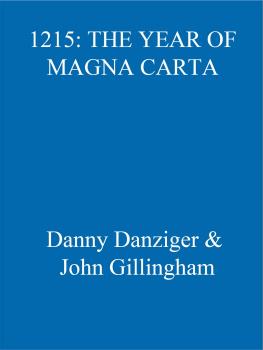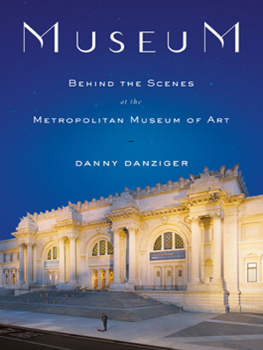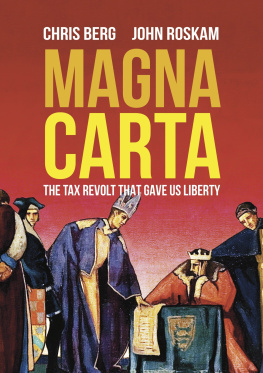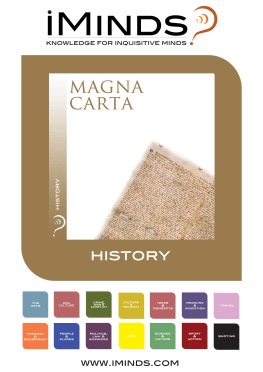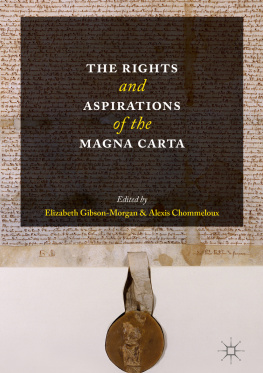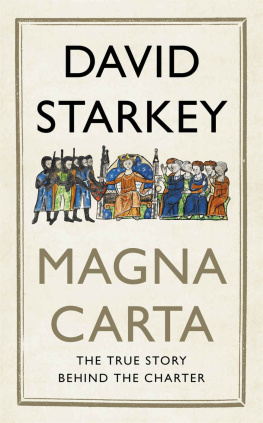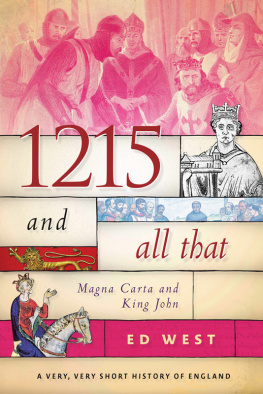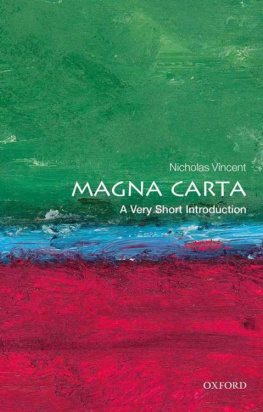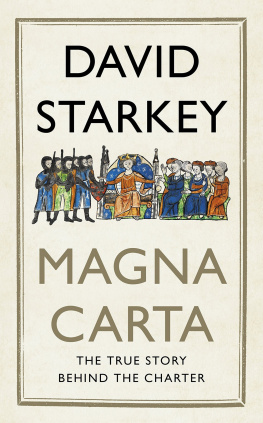1215: THE YEAR OF MAGNA CARTA
Danny Danziger & John Gillingham
www.hodder.co.uk
Released by:
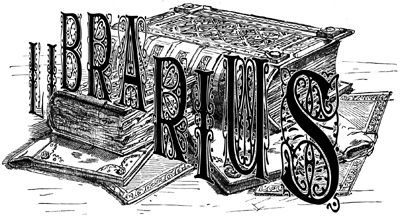
2014.10.8
Copyright 2003 by Danny Danziger and John Gillingham
First published in Great Britain in 2003 by Hodder & Stoughton
An Hachette UK Company
The right of Danny Danziger and John Gillingham to be identified as the Authors of the Work has been asserted by them in accordance with the Copyright, Designs and Patents Act 1988.
All rights reserved.
No part of this publication may be reproduced, stored in a retrieval system, or transmitted, in any form or by any means without the prior written permission of the publisher, nor be otherwise circulated in any form of binding or cover other than that in which it is published and without a similar condition being imposed on the subsequent purchaser.
A CIP catalogue record for this title is available from the British Library
Epub ISBN 978 1 444 71734 1
Book ISBN 978 0 340 82475 7
Hodder & Stoughton Ltd
An Hachette UK Company
338 Euston Road
London NW1 3BH
www.hodder.co.uk
For Caroline, and Toby, Mary and Guy
For Brenda, Emma, Kate, Simon and Tom
Contents
Introduction
The Treasures Gallery of the British Library is an extraordinary place. The hum of the humidifiers drowns out the endless roar of traffic along Londons Euston Road; it is calm and quiet in the Gallery. The lights are very low; it takes a little time to adjust your eyes to the gloom, but too bright a light would damage the priceless books and manuscripts that lie in cases and displays around the warren of rooms.
Shakespeares First Folio and Leonardo da Vincis notebook, with his extraordinary mirror-image right-to-left handwriting, are open to view, as well as dozens of books of such physical beauty as to rival any painting. There is the Lindisfarne Gospels, written and illuminated by the monk Eadfrith in honour of St Cuthbert around AD 698, in the monastery of Lindisfarne, on Holy Island, just off the coast of Northumbria. That was roughly around the time that Bede was writing his history of the English Church and its people. It is wonderfully illuminated, with incredible, vivid colours. At a time when most other books in Europe tended to use only three, this book has virtually every colour you could imagine: rich ruby reds and intense aquamarines along with deep, majestic purples.
Beowulf is in the gallery too, and the Barcelona Hagadah, named after the heraldic shield it bears, an exquisite Hebrew service book from 1350, still read each year in Jewish homes at the Seder meal on the eve of Passover. The Sherborne Missal, the Roman Catholic book of prayers made for Sherborne Abbey in Dorset between 1400 and 1407, is there. It is a masterpiece of book painting, a massive volume of seven hundred pages, with lavishly decorated margins peopled by kings, nobles, bishops, monks, saints and angels in a celestial throng and, most unexpected of all, a choir of the native birds of the British Isles. It is possibly the only service book of stature to have survived the Reformation intact. Continuing around the Treasures Gallery, there are manuscript scores by Mozart, Handel, Chopin and Beethoven, handwritten lyrics of two of The Beatles most famous songs, Ticket to Ride and I Want To Hold Your Hand, and theres a Gutenberg Bible. In the mid-fifteenth century, Johannes Gutenberg invented a way of mechanising the production of type, and the Bible he printed in Mainz, around 1485, was the first major book printed in the West. About 180 copies were made, and significant parts of forty-eight copies still survive. The British Library has two complete copies, and the cover of the one on display is richly illuminated in gold; it is a thing of beauty.
But what we have come to see, laid out under a bullet-proof glass casing, isnt illuminated: it has no drawings or illustrations in the margins, and, to be perfectly frank, is a dull, rather ugly-looking thing. There is, however, a bigger crowd here than at any other exhibit. There are Japanese tour-leaders waving umbrellas, and Americans who breathe reverentially over the glass. Even French schoolchildren are a little less boisterous in front of it. Everyone here, from these nations and many others, has come to see it before they see anything else, and believes it to be an important document.
What we are looking at is a single sheet of parchment. Originally, it would have had a green and black wax seal, attached to a vellum strip at the bottom of the Charter, that would have shown the King, King John, enthroned, and holding his sceptre. But it is rare for the document and the seal to have survived together for such a long time. It is quite densely arranged, lots of long lines in a cursive but quite showy hand, not written in the characteristic Gothic script you see in music and liturgical manuscripts.
The parchment is slightly oblong, almost square. When it was written, in 1215, they were using a gall-based ink. If you look at an oak tree, you will see little pimples, called galls, growing from the bark. They develop when a wasp stings the tree to lay its eggs: the tree prevents the poison spreading by forming a little nut around it. If you tap into that nut, you get a clear liquid, an acid almost; when this is used as an ink on parchment or vellum, it etches itself into the membrane. And when you add something like soot, or most effectively, iron salts, the ink turns a rich dark colour, although over time it will fade to a mid-brown. The ink here has retained its blackness pretty well those scribes were professionals and knew how to mix their materials. Their pens were quills: they would have taken the flight feather of a goose, possibly a swan, and cut it into shape. If you were right-handed, you took a left wing feather, because the feather curves the other way, and you compensated according to the direction in which you wrote. Every ten lines or so, possibly less, depending on how long the lines were, youd dip your quill into the ink and re-trim the nib with a penknife which is where the word comes from.
This document, which we know as Magna Carta, was at first known as the Charter of Liberties. A few years later it became known as Magna Carta, the big charter, to distinguish it from another important, but much shorter, contemporary piece of legislation, the Forest Charter.
We dont know for sure how many copies of the big charter were made in 1215, but only four exist now. One is in Lincoln Cathedral; another is at Salisbury Cathedral. The remaining two are in the British Library, and it is a miracle they both exist, because one of them was badly damaged by a fire. Before the government set up a British Museum and Library, the charter was kept in an outhouse store, roughly on the site where Westminster School is now, close to Westminster Abbey. One night, late in the year of 1731, a fire broke out, and despite the best attempts of the librarian and his father-in-law to save what they could, certain documents, including a copy of Magna Carta, and the Beowulf manuscript, were badly damaged, and has gradually deteriorated over the years.

